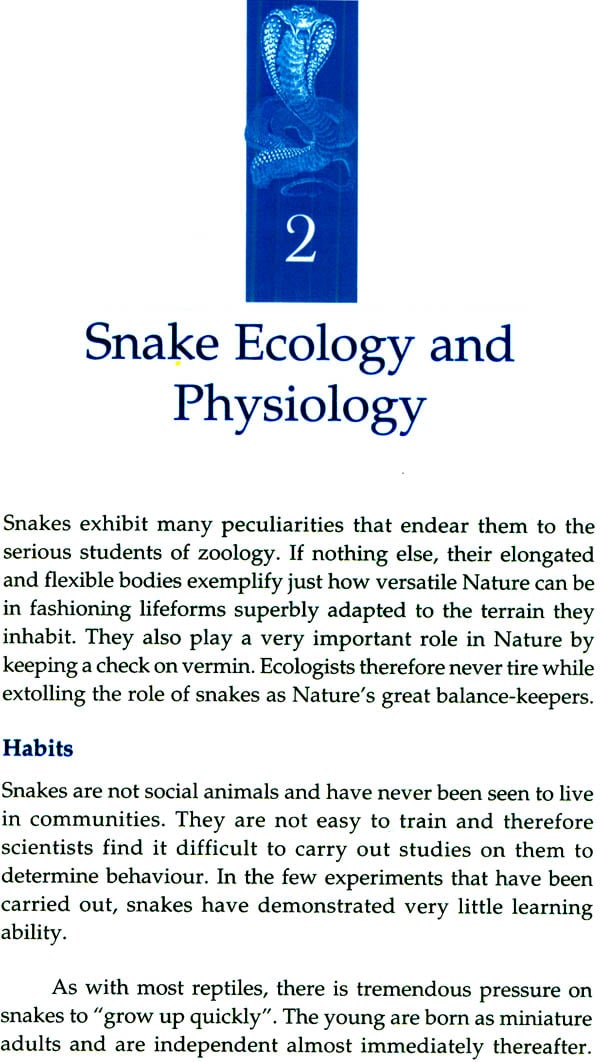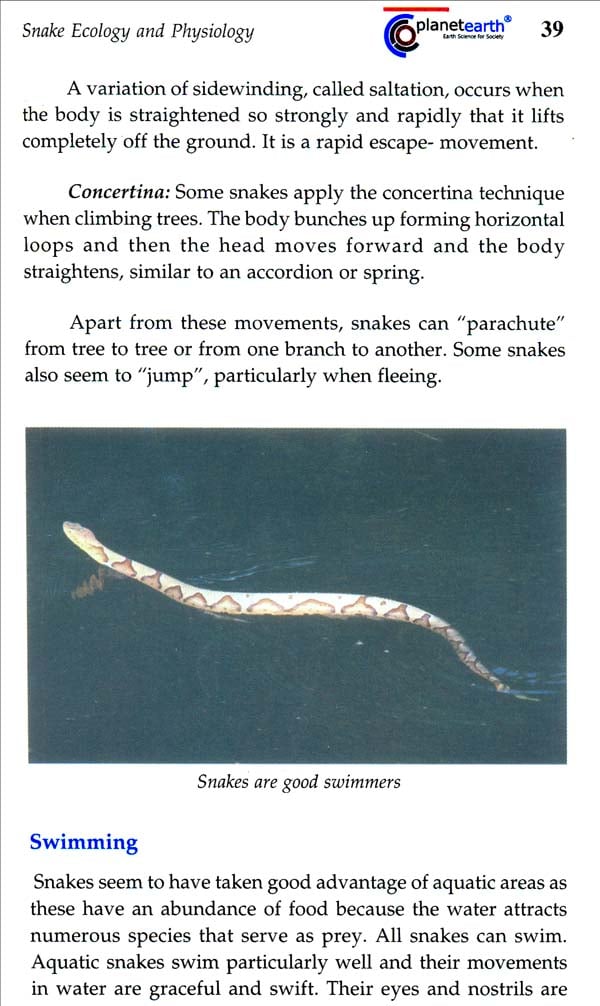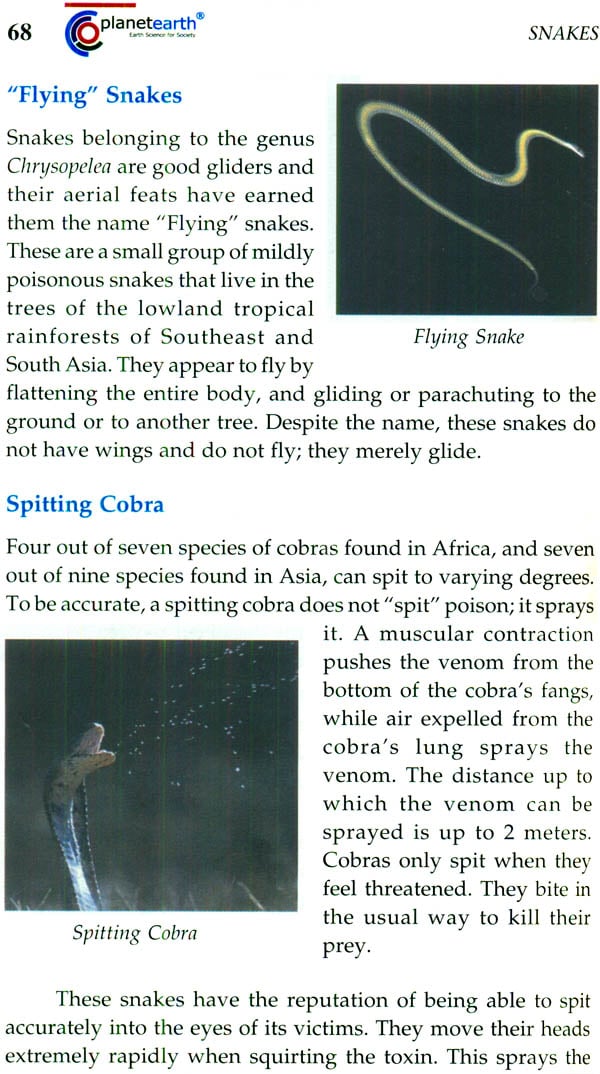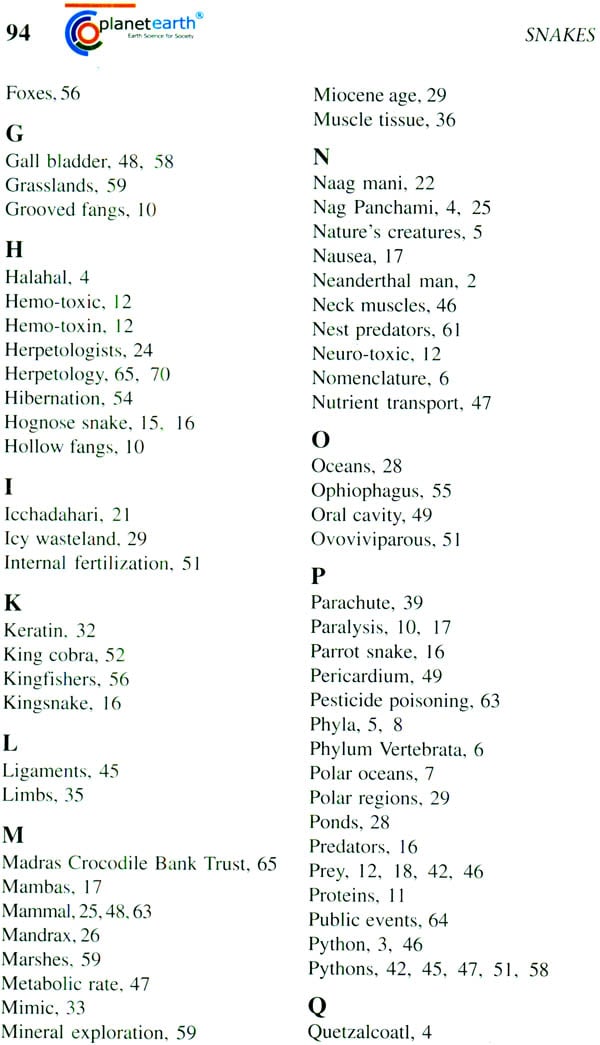
Snakes
Book Specification
| Item Code: | NAJ365 |
| Author: | Sukanya Datta |
| Publisher: | Vigyan Prasar |
| Language: | English |
| Edition: | 2008 |
| ISBN: | 9788174801630 |
| Pages: | 110 (Throughout Color Illustrations) |
| Cover: | Paperback |
| Other Details | 8.5 inch X 5.5 inch |
| Weight | 170 gm |
Book Description
About the Book
No one denies the need to understand the interactions of air, soil, water, Earth’s atmosphere, land, oceans, ice and life as a single connected system. We need to do this to really study the Earth as a single connected system. And to be able to do so, we need to appreciate the beauty and importance of every denizen on Earth including the most humble and the most insignificant.
Snakes arc perhaps the most misunderstood and therefore, the most maligned creatures on Earth. Human attitude towards this group of animals has been strangely paradoxical. We either worship them or else we kill them on sight. They are one of Life’s great treasures themselves, misunderstood, persecuted and now, brought to the brink of extinction by habitats degraded or encroached upon by man. We owe it to ourselves to learn a little bit more about Snakes, our co-inhabitants of Planet Earth and this booklet is a small effort in that direction.
About the Author
Sukanya Datta acquired her doctorate in zoology from the University of Calcutta, before joining the Council of Scientific and Industrial Research as a Scientist. She has authored many books (including an encyclopedia of S&T) both singly and jointly with co-authors. She has had a long stint as Associate Editor, Science Reporter-India’s premier popular science magazine. She has been actively involved in the popularization of science for the last sixteen years and has many published articles, radio scripts and book reviews to her credit.
Foreword
Earth is the only planet we know of with life on it. Animals, Plants and microorganisms maintain a delicate balance with a variety of life forms we call Biodiversity. Each species depends on other species for its existence. When we talk of life on earth, we also talk about the human species. If we need to understand and preserve our environment, we shall need to understand the interdependence of the species on each other and the importance of natural resources like air, water and soil for living beings.
Life has continued to evolve on this earth over millions of years adapting to changing environment. Only those species have survived that have adapted to the changing environment. This change could be due to natural causes like earthquakes, eruption of volcanoes, cyclones, and so on. It even could be due to climate change. However, quite often this change is brought about by the species higher up in the ladder of evolution that tries to control environment to suit its needs and for development. This is precisely what human species has done to our fragile planet.
We need energy for development; which we traditionally obtain by burning natural resources like firewood, coal and petroleum. This is what we have been doing for centuries. Today there is consensus that human activities like burning of fossil fuels and consequent pumping of gases like carbon dioxide into atmosphere have been responsible for the earth getting hotter and hotter. Today, there are threats to our planet arising from climate change, degrading environment, the growing rate of extinction of species, declining availability of fresh water, rivers running dry before they can reach sea, loss of fertile land due to degradation, depleting energy sources, incidence of diseases, challenge of feeding an exponentially growing population, and so on. The human population is now so large that the amount of resources needed to sustain it exceeds what is available. Humanity’s environmental demand is much more that the earth’s biological capacity. This implies that we are living way beyond our means, consuming much more than what the earth can sustain.
To draw the attention of the world to these aspects and in an attempt to establish that environment is where we live; and development is what we all do in attempting to improve our lot, within that abode, the United Nations has declared the year 2008 as “The Year of the Planet Earth”. It is hoped that with the cooperation of all we shall be able to save the biodiversity and the life on this planet. A host of activities and programmes are being organized all over the world for this purpose. One of the important aspects is to make people aware about the challenges we face and the possible solutions to save this planet from heading towards catastrophe. It is with such thoughts that Vigyan Prasar has initiated programmes with activities built around the theme “The Planet Earth”. The activities comprise of development and production of a series of informative booklets, radio and television programmes, and CD-ROMs; and training of resource persons in the country in collaboration with other agencies and organizations.
It is expected that the present series of publications on the theme “The Planet Earth” would be welcomed by science communicators, science clubs, resource persons, and individuals; and inspire them initiate actions to save this fragile abode of ours.
Preface
The General Assembly of the United Nations has unanimously adopted a resolution that was co-signed by 82 nations, to proclaim 2008 as the International Year of Planet Earth (IYPE). This UN year will be the core of a triennium, starting in 2007 and continuing until the end of 2009. It is a joint venture of the International Union of Geological Sciences and former Earth Science Division of UNESCO. The Year’s purpose is encapsulated in it strapline “Earth sciences for society.” The avowed aim of the International Year of Planet Earth is to demonstrate new and exciting ways in which Earth sciences can help future generations meet the challenges involved in ensuring a safer and more prosperous world.
Earth is the only planet we know to be capable of sustaining life. Even a cursory glance around us shows that the Earth is a complex and dynamic system. No one denies the need to understand the interactions of air, soil, water and living elements-Earth’s atmosphere, land, oceans, ice and life- as a single, connected system. We need to do this to really study the Earth as a single connected system. And to be able to do so, we need to appreciate the beauty and importance of every denizen on Earth ... including the most humble and the most insignificant.
Snakes are perhaps the most misunderstood and therefore, the most maligned creatures on Earth. Human attitude towards this group of animals has been strangely paradoxical. We either worship them or else we kill them on sight. Most of us are afraid of them though we do hold them in awe too. They move, swim, climb trees and hunt without seeming to miss the limbs they do not have. They strike swiftly and kill silently either by strangulating and suffocating the victim or by means of venom. But in reality they are retiring creatures that would rather flee than confront and stalking humans to extract revenge is not part of their plans. They are not manifestations of semi-divine supernatural beings that sometimes walk the Earth, nor are they guardians of hidden treasure. They are one of Life’s great treasures themselves, misunderstood, persecuted and now, brought to the brink of extinction by habitats degraded or encroached upon by man. We owe it to ourselves to learn a little bit more about Snakes, our co-inhabitants of Planet Earth and this booklet is a small effort in that direction.
Contents
|
| Foreword | vii |
|
| Preface | xi |
| 1. | Clearing Myths and Misconceptions | 1 |
| 2. | Snake Ecology and Physiology | 27 |
| 3. | Interesting Trivia | 67 |
|
| Glossary | 91 |









